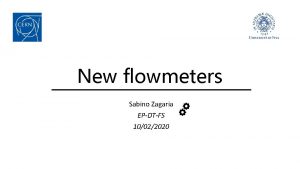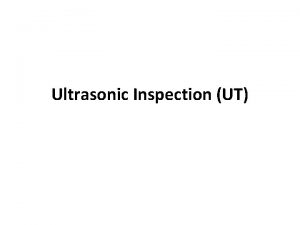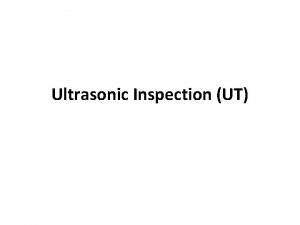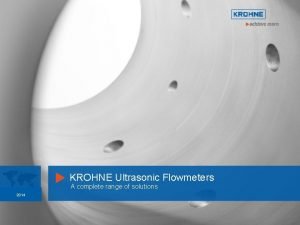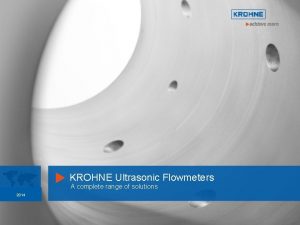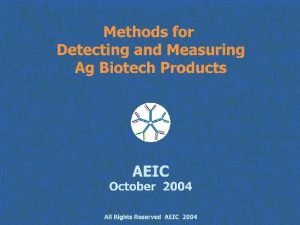SONARtrac vs Ultrasonic Flowmeters 1232020 All Rights Reserved











- Slides: 11

SONARtrac® vs Ultrasonic Flowmeters 12/3/2020 All Rights Reserved. Copyright Ci. DRA 2015 1

SONARtrac vs Ultrasonic Flowmeters Primary Differentiators Ci. DRA SONARtrac Flowmeter Ultrasonic Flowmeter Representative measurement Full bore measurement Measurement only from information along ultrasonic path Capable of measuring slurries yes Reliable measurement in presence of scale build-up Accurate velocity measurement limited no Doppler: Low levels only Works in presence of entrained air bubbles yes Can measure level of entrained air yes no Works on lined pipes (rubber, teflon, etc) yes maybe Works on fiberglass pipes yes maybe Requires coupling gel no yes Sensors require special alignment no yes periodic none Maintenance requirements Life cycle cost 12/3/2020 No drift mechanism Does not wear out lowest All Rights Reserved. Copyright Ci. DRA 2015 Transit Time: No Requires reapplication of ultrasonic gel (couplant) Requires periodic re-calibration medium 2

General Issues with Ultrasonic Flowmeters Doppler and Transit Time Ultrasonic Meters § § § Require good acoustic conduction through pipe wall and liners. Will not work well for pipes with cemented lining. Will have problems with fiberglass pipes Ultrasonic Transducer Signal is Attenuated or May be Lost to Transducer Entirely Attenuation through liner or interfaces Scattering Losses Pipe Wall Refraction Angle Change in Beam Angle Generates Loss in Accuracy Ultrasonic Transducer Attenuation of Signal and Change in Beam Angle Drying out of gel will cause loss of signal Liner Ultrasonic Transducer 12/3/2020 Ultrasonic Transducer Attenuation in the liner or interfaces All Rights Reserved. Copyright Ci. DRA 2015 3

Doppler Ultrasonic Flowmeters Primary problems with operation: § § § Scale causes attenuation and refraction of the signal. Continuous maintenance because the gel/couplant dries. Low accuracy (+/- 20% unless calibrated on the pipe, but accuracy cannot be maintained) Measurement is proportional to the cosine of the beam angle into the flowing material; as that is a small angle, even tiny changes of that angle (due to gel, contact, scale etc…) cause a big error in the measurement. Measurement made using reflections, rather than measuring through the pipe so majority of the information gathered from volume is close to the pipe wall, making it sensitive to flow velocity profile and variations. Additional problems: § § § 12/3/2020 Does not work with pure liquids. Requires solids/bubbles. Requires minimum % of solids (~5%) Requires minimum particle size (~ >100 um) Not accurate in presence of high concentration of solids Affected by bubbles (bubble velocity in vertical pipes is different than flow velocity, which causes attenuation of the signal and inaccurate measurement) All Rights Reserved. Copyright Ci. DRA 2015 4

Doppler Ultrasonic Flowmeters Impact of Scale Build-up and Solids/Bubbles Ultrasonic Transducer Low Levels of Solids/Bubbles: Normal Operation Refraction of Ultrasonic Waves Ultrasonic Transducer Scale Buildup: Loss of accuracy and eventual loss of signal Change in Beam Angle Generates Loss in Accuracy Scale Ultrasonic Transducer High Levels of Solids/Bubbles: Loss of signal due to excessive amount of bubbles/solid particles 12/3/2020 Attenuation of Signal and Change in Beam Angle Attenuation in the Scale Ultrasonic Transducer Liquid with Excessive Bubbles or Solid Particles Ultrasonic Transducer Loss of Signal Resulting in Loss of Measurement All Rights Reserved. Copyright Ci. DRA 2015 5

Doppler Ultrasonic Flowmeters Accuracy Issues on Horizontal Lines Accuracy dependent on knowing the precise angle of ultrasonic beam Ultrasonic Transducer Refraction of Ultrasonic Waves Ultrasonic Transducer The angle changes at every interface. Unknowns in the acoustic velocity of the liner and the slurry contribute to errors in the measurement. If the transducers are not perfectly aligned, errors in the angle will also occur and cause measurement errors. 12/3/2020 All Rights Reserved. Copyright Ci. DRA 2015 6

Doppler Ultrasonic Flowmeters Accuracy Issues on Horizontal Lines Air bubbles will rise faster than the slurry. Doppler meters will tend to track bubbles over solids. This will cause the meter to over read the flow. Ultrasonic Transducer 12/3/2020 Ultrasonic Transducer All Rights Reserved. Copyright Ci. DRA 2015 7

Transit-Time Ultrasonic Flowmeters Primary problems with operation: § § Scale causes attenuation and refraction of the signal. Continuous maintenance because the gel/couplant dries. Accuracy is +/- 5% unless calibrated on the pipe. No measurement if the flow has more than 10% solids/bubbles. Additional problems: § Developed to work with only pure liquids. § High concentration of solids is a problem. § Measurement affected by any presence of bubbles (less than 10%), which causes attenuation of signal and measurement failure. Transit-Time Ultrasonic flow meters are not recommended for slurry applications, which is known to have more than 10% of solid/bubble content. 12/3/2020 All Rights Reserved. Copyright Ci. DRA 2015 8

Transit Time Ultrasonic Flowmeters Impact of Scale Build-up and Solids/Bubbles Ultrasonic Transducer Clear Fluids: Normal Operation Scale Buildup: Loss of accuracy and eventual loss of signal Refraction of Ultrasonic Waves Reflection Signal is Attenuated or May be Lost to Transducer Entirely Ultrasonic Transducer Scale Attenuation through Scale Scattering Losses Pipe Wall Refraction Angle Change Bubbles and Solids: Loss of signal Loss of Signal from Attenuation Results in Loss of Measurement Ultrasonic Transducer Liquid with Air Bubbles or Solid Particles Ultrasonic Transducer Large Amount of Attenuation Pipe Wall 12/3/2020 All Rights Reserved. Copyright Ci. DRA 2015 9

SONARtrac vs Ultrasonic Flowmeter Benefit Summary § Representative Measurement: § SONARtrac meters use the entire pipe volume. § Ultrasonic meters only use the information along ultrasonic path, making it highly sensitive to particles or other acoustic impedance mismatches. § Reliability: § SONARtrac meters do not lose velocity measurement in presence of scale. § Ultrasonic meters lose accuracy in presence of scale. § Entrained Air: § The entrained air measurement feature of the SONARtrac can be used to correct both density and flow. § Ultrasonic flow meters cannot measure entrained air, and their accuracy can be affected by the presence of air bubbles. 12/3/2020 All Rights Reserved. Copyright Ci. DRA 2015 10

SONARtrac vs Ultrasonic Flowmeter Benefit Summary § Maintenance: § SONARtrac meters require little to no maintenance. § Ultrasonic meters require reapplication of gels/couplants. § Operation: § SONARtrac meters measure in presence of solids/bubbles. § Ultrasonics have a very limited range of operation with solids/bubbles. 12/3/2020 All Rights Reserved. Copyright Ci. DRA 2015 11
 Sonartrac
Sonartrac Microsoft corporation. all rights reserved
Microsoft corporation. all rights reserved Gssllc
Gssllc All rights reserved sentence
All rights reserved sentence All rights reserved c
All rights reserved c Warning all rights reserved
Warning all rights reserved Copyright 2015 all rights reserved
Copyright 2015 all rights reserved Airbus deutschland gmbh
Airbus deutschland gmbh Microsoft corporation. all rights reserved
Microsoft corporation. all rights reserved Microsoft corporation. all rights reserved.
Microsoft corporation. all rights reserved. Pearson education inc all rights reserved
Pearson education inc all rights reserved Creative commons vs all rights reserved
Creative commons vs all rights reserved













